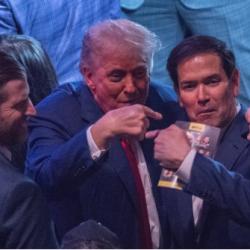I used to work for a nonprofit outfit that the grant-writers referred to as a "capacity-building institution." We didn't do much ourselves, in other words, we mainly tried to get others to do things. Or, again in the parlance of our grant-writers, we sought to "inform, inspire and equip" others to act. Specifically, we wanted them to act to help the poor and the powerless.
Mainly, we put out a magazine, for which I was a writer and editor. Our intended audience was "evangelicals" — an infamously difficult to define demographic.
Broadly speaking, evangelicals take very seriously the admonition in James 1:27 "… to keep onself from being polluted by the world." They take this so seriously, in fact, that they're wary of heeding the first part of that verse — "to look after orphans and widows in their distress." Looking after such people involves interacting with the world, after all, and thus risking "being polluted." Or, as my late coworker and friend Dwight Ozard used to put it, evangelicals tend to be so intent on keeping their hands clean that they're afraid to get their fingernails dirty.
We offered plenty of arguments for why evangelical Christians ought to consider helping the poor a high priority. The problem with that approach, though, was that arguments seem to invite counter-arguments. A narrative, on the other hand — a story — can get around such reflexive defensiveness. So we told a lot of stories.
The stories we told were of people, mostly evangelical Christians themselves, who weren't afraid to get their fingernails dirty. Their stories were challenging and inspiring to me, so I suspected and hoped that they would be challenging and inspiring to others as well. These were very cool people doing very cool things and they were making a difference, one person, one block, one neighborhood, one classroom, one village at a time.
I kept a map of the United States on the bulletin board by my desk and every time we ran one of these stories I would stick a little red pushpin into the map, representing each person or congregation or nonprofit ministry whose story we had told. There was a pushpin in Waco, Texas, for the Church Under the Bridge, and one in Athens, Ohio, for Good Works Inc., and one in Pasadena, Calif., for Urban Onramps. There was a pushpin in Harrisburg, Pa., and one in White Plains, N.Y. And there were little clusters of pushpins in Chicago, Philadelphia, Washington, Los Angeles, New York City.
When I ran out of little red pushpins, I switched to dots from a red Sharpie. What started as, in part, a way of tracking the geographic diversity of the stories we told soon became, for me, a source of hope. Feeling discouraged? Look at the map. Look at all that's being done. Loaves and fishes, etc.
My boss had been collecting stories like this since before I was born and he was even more enthusiastic than I was about the impact of all this good work being done. He saw how much these good people were able to accomplish with little more than devotion and dedication and he imagined how much more they might do if they had access to more substantial resources, if they had more to work with than a shoestring budget. And so my boss became an enthusiastic proponent of what was then called "charitable choice."
The idea, briefly, was to allow these ministries and church groups to apply for government money. Those additional funds, he was certain, would allow these groups to produce additional results, to change more lives, to make more of a difference.
I didn't share his enthusiasm. I had First Amendment concerns — concerns that, for me, were not only constitutional, but also theological. I distrusted the motives of some of the other proponents of this idea. I doubted that their market-based analogies of entrepreneurial supply and demand really translated into this pervasively altruistic "marketplace." And I had a dozen or so other worries and questions that I had a hard time getting my boss to address or consider.
But in addition to and underlying all of that, there was this: there weren't enough little red pushpins in the map. There were more than a hundred, and there were probably hundreds more I could have added. But not thousands.
I could see some merit in charitable choice, with careful First Amendment safeguards, if it were being put forward as a modest step, an incremental measure that might leverage some few steps forward for community development, education, neighborhood health care, etc. This was in the mid-'90s, after all, and such incremental, Clintonian measures were in vogue.
But the proponents were advocating this idea with a revolutionary zeal. I would look at one of those little red pushpins and think about the people and the work it represented. That group might be helping 20 people a year to find shelter, or jobs, or an education. And maybe with a bit more funding, they might be able to help 25 or even 30 people instead. But what would happen if we asked them to help 50 or 100 people? What if — because this seemed to be where the proponents of this idea were headed — what if instead of just asking these groups to do more to supplement the work of larger, more bureaucratic programs, we asked them to replace those programs? Could they do so while maintaining the distinctive character that made them so effective on a smaller scale? Could they even survive?
So when given the chance to get in on the ground floor as an early advocate of charitable choice, I respectfully declined. I took a pass. Too many unanswered questions.
That didn't endear me to my boss, of course, but I don't regret it. What I regret was taking a pass instead of pressing the point, because in the years since then many of those questions have been answered, and the answers weren't good.












